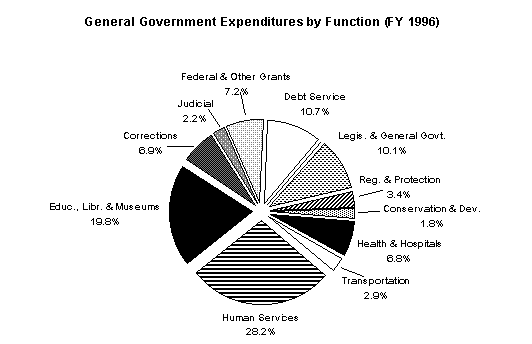
Background
In reviewing the annual financial performance of Connecticut's state government, there is a tendency
to focus attention exclusively on the General Fund. The General Fund is the largest single state fund
accounting for a little over 80 percent of all governmental financial transactions. General Fund fiscal
results are usually reported on a modified cash basis of accounting. While this is presently the method
of accounting prescribed by state law, it is not in compliance with Generally Accepted Accounting
Principles (GAAP). The accounting profession developed GAAP as the standard for a fair and
accurate presentation of financial data. Focusing exclusively on the fiscal results of the General Fund
on a non-GAAP, modified cash basis of accounting creates a distorted picture of the state's true
financial position.
As explained earlier, on a modified cash basis of accounting, revenues are recognized when the obligation to make the payment is incurred. In other words, revenue that is owed to the state is counted even though it has not yet been received. On the other hand, the money the state owes is not recognized as an expenditure until a payment is actually processed and the check is issued. Using this accounting practice, it is possible to create a surplus in a current fiscal year by delaying some payments until the next fiscal year. GAAP requires that expenditures be recorded when the obligation is incurred, without regard to the timing of payment; likewise, revenues are counted when the liability is incurred and the amount of the receipts is measurable.
Determining the state's financial health by analyzing the modified cash basis results of the General Fund alone can produce incomplete and inaccurate conclusions. For example, the state posted a modified cash basis General Fund surplus of $250 million in Fiscal Year 1996; however, hindsight reveals that this surplus would have been almost entirely eliminated if the state had not refinanced $240.7 million in outstanding Economic Recovery notes (debt notes) that were payable that year. In order to refinance those notes, the state will pay an additional $20 million in interest costs over the next three years.
The Comptroller's Report: Connecticut's Economic Health provides a GAAP-based analysis of all state governmental fund activities. It is, therefore, a comprehensive and accurate review of the state's financial health.
Operating Results
The General Fund has posted operating surpluses in three of the past five years; however, when the
operating results for all governmental functions are considered (which include the General Fund, all
special revenue funds, the debt service fund, and transfers to higher education) deficits result in each
of the past five years.
| FY 96 | FY 95 | FY 94 | FY 93 | FY 92 | |
|---|---|---|---|---|---|
| General Fund Surplus (Deficit) | $ 198 | $(242) | $ 51 | $ 93 | $ (77) |
| Special Revenue Funds: | |||||
| Transportation | 14 | 17 | (10) | (36) | 3 |
| Grant and Loan Programs | (301) | (307) | (306) | (283) | (232) |
| Housing Programs | (36) | (32) | (54) | (39) | (37) |
| Other, net | (66) | (59) | (46) | 5 | (20) |
| Total | (389) | (381) | (416) | (353) | (286) |
| Total Gov't Operating Deficits | $(191) | $(623) | $(365) | $(260) | $(363) |
| Total Cumulative GAAP Deficit | $(640) | $(577) | $(466) | $(504) | $(477) |
The 1996 Fiscal Year operating deficit of $191 million is at a five-year low, both in absolute terms and as a percentage of total state tax revenue. However, this is the ninth straight year of state government operating deficits. These deficits result, in large part, from a persistent reliance on debt financing to cover the cost of state operations. State expenditures are shown by major budget category below.

Human services, corrections and debt service have seen the largest expenditure increases, with each category growing three-fold or more since Fiscal Year 1987. The increase in the human services component has been driven largely by Medicaid spending, which has doubled from $994 million in Fiscal Year 1990 to $1.9 billion in Fiscal Year 1996. Medicaid spending showed no growth between Fiscal Year 1995 and 1996, a fact that contributed to a slower 2.5 percent growth rate in total state spending for the year. The state's correctional facilities have seen an upward trend in their inmate population, growing from 8,777 in Fiscal Year 1990 to 15,135 in Fiscal Year 1996. Outstanding debt and the related debt service requirements have continued to grow as well. Per capita state debt has more than doubled since 1990, increasing from $1,204 to $2,670 in 1996.
As demonstrated below, the rate of growth in state spending is beginning to level off. State operating expenditures, $12.2 billion in Fiscal Year 1996, increased a modest 2.5 percent rate from the prior year.
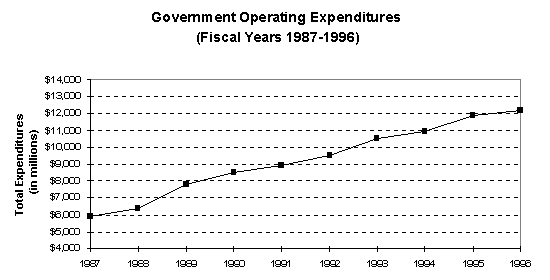
Fiscal Year
Most tax revenues are paid to the General Fund and for Fiscal Year 1996 the General Fund tax receipts totaled $6.8 billion. The chart on the following page shows the sources of these tax revenues.
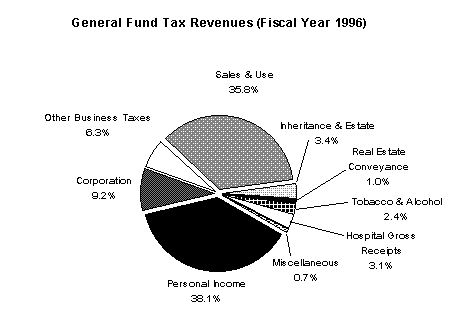
Since 1987, total state tax collections have increased 82 percent, due in large part to the adoption of a state income tax. Between Fiscal Year 1995 and 1996 alone, state tax collections rose 7.6 percent. The increased tax receipts were the result of generally improved national and state economies, and strong financial market performance that created large capital gains tax receipts for the state.
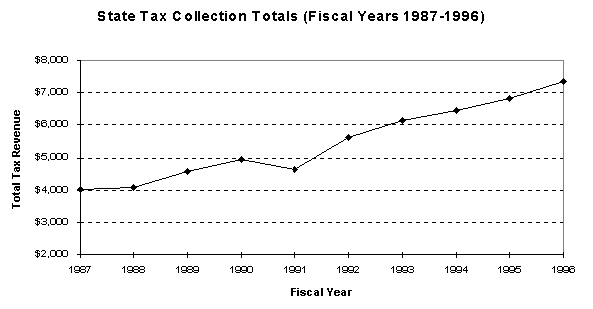
Propelled by higher tax receipts, total state revenues (which include taxes, licenses, permits, fees, federal grants, lottery proceeds and investment earnings) have doubled since Fiscal Year 1987, rising from $5.9 billion to $11.8 billion in Fiscal Year 1996.
The slower growth in state spending, combined with strong revenue growth, has dramatically improved the state's overall financial position. The state's operating deficit dropped from $623 million in Fiscal Year 1995 to $191 million in Fiscal Year 1996. Although deficits continue to result from the operation of state programs, progress is being made in reducing those deficits.
Debt Position
In Fiscal Year 1996, the state issued $1.364 billion in bonds and notes, which was new borrowing for
the year. This represented a 26 percent increase from the Fiscal Year 1995 debt issuance level of
$1.079 billion. The level of debt issued in a given fiscal year is largely influenced by the timing of
state projects. For example, the first bonds for the UCONN 2000 project were issued in Fiscal Year
1996. Outstanding bonded debt, which consists of bonds issued in all prior years that have not yet
been paid, increased from $8.412 billion in Fiscal Year 1995 to $8.981 billion in Fiscal Year 1996.
The state issues debt to fund various activities including acquisition, construction, and renovation of state buildings and facilities like our colleges and universities; construction and improvements to roads and bridges; and preservation of farmland and open space. Funds for these projects are borrowed because they require a large initial capital investment and will provide long-term benefits to the citizens of the state. However, the state also issues debt to fund recurring program activities, especially in the areas of conservation, development and education. This practice of borrowing to fund annual operating activities should be avoided because interest must be paid on the borrowed money. The repayment of interest and principal is referred to as debt service.
In Fiscal Year 1990, 5.4 percent (or $465 million) of all government spending went to debt service. By Fiscal Year 1996, 10.7 percent (or $1.3 billion) of all state spending was committed to debt service.
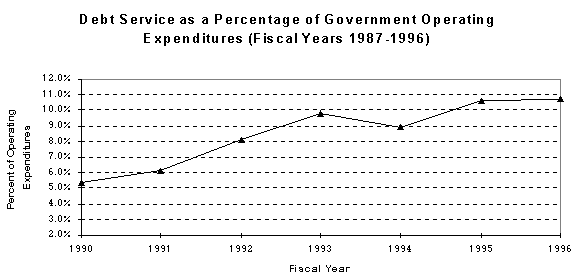
The state's continued reliance on bonded debt creates ever increasing debt service requirements, leaving less money available for state government to address the needs of Connecticut's citizens.
To demonstrate the growth in state debt, it is useful to calculate the amount of outstanding bonded debt attributable to each man, woman and child in Connecticut. This measure is referred to as net debt per capita. The growth in net debt per capita is shown on the chart below.
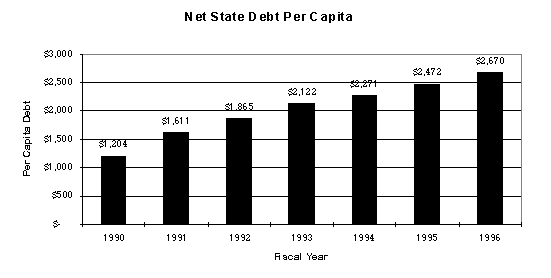
It is important to note that the state has been working to reverse the growth in debt. For Fiscal Year 1996, the State Legislature reduced bond authorizations for future programs and projects 9 percent below the level authorized for Fiscal Year 1995. If this trend continues into the future, the state's bonded debt picture will improve.
Bonded debt is the primary focus of most analyses of state debt. But this measure represents only part of the state's debt picture. In addition to bonds and notes, the state has long-term obligations to pay, including unfunded pension benefits; compensated absences such as vacation leave that have been earned by state employees but have not yet been paid; workers' compensation claims, which arose from past events but will be settled in future periods; and capital leases. When these additional long-term obligations are added to the state's bonded debt, total debt rises from $8.981 billion to $14.931 billion in Fiscal Year 1996. Last year alone, long-term state debt increased by a staggering $827 million. The significance of this should not be lost; the debt we create today will be left for our children to pay.
Trends in selected long-term state debt by component part are presented in the table below.
| FY 96 | FY 95 | FY 94 | FY 93 | FY 92 | |
|---|---|---|---|---|---|
| Net Bonded Debt | $ 8,981 | $ 8,412 | $ 7,994 | $ 7,659 | $ 7,031 |
| Capital Leases | 54 | 56 | 55 | 50 | 50 |
| Compensated Absences | 262 | 257 | 267 | 175 | 174 |
| Workers' Compensation | 268 | 287 | 295 | 304 | 298 |
| Subtotal | 9,565 | 9,012 | 8,611 | 8,188 | 7,553 |
| Actuarial Unfunded Pension Benefit Obligation | 5,366 | 5,092 | 5,455 | 5,165 | 5,731 |
| Total | $14,931 | $14,104 | $14,066 | $13,353 | $13,284 |